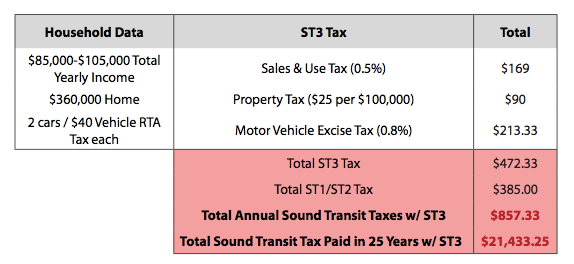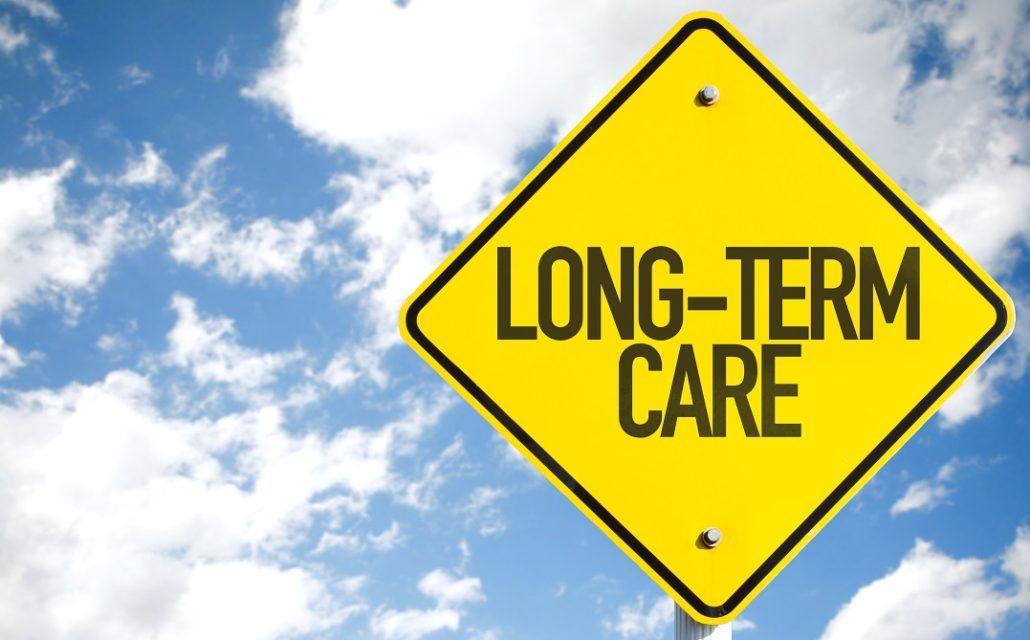This November, voters in the Sound Transit taxing district living in parts of King, Pierce and Snohomish counties will decide whether or not to pass Sound Transit’s new $54 billion-dollar tax proposal, called Sound Transit 3 (ST3).
The majority of the project funding is for light rail, which would attract only 64,800 new riders to public transit, or a little over six percent of the projected one million people that planners expect to move to the region by 2040.
If ST3 is approved, Sound Transit officials would collect the following taxes annually from each household:

To put these numbers into perspective for an average household, a tax calculator was created at www.ST3Tax.com. Residents in the taxing district can input their house-hold data to determine how much they would pay to Sound Transit if they approve ST3.
Below is a calculation from www.ST3Tax.com for a two-person household bringing in a combined yearly income of $85,000 to $105,000 with two cars and a $360,000 home. Total costs for this family for ST1, ST2 and ST3 taxes over 25 years would be $21,433.

Sound Transit officials project transit ridership to reach 1.1 to 1.332 million daily boardings by 2040 with ST3. Without ST3, that range would be 975,000 to 1.169 million.
A closer evaluation of this data shows that there would be only 144,000 new transit boardings generated with ST3.1
This means that ST3 specifically would serve only 0.7 percent, including buses and light rail, of all 19 million regional daily trips. When the metric of 144,000 new boardings is converted to riders, the result is only 64,800 new riders on Sound Transit and other regional transit as a result of ST3. 2
Allowing for Sound Transit’s most optimistic ridership projection of 695,000 daily boardings by new and existing riders on all of Sound Transit’s services (light rail, commuter rail, bus rapid transit, and express bus), the agency would serve barely four percent of all daily trips in the region by 2040.3
No matter how Sound Transit’s reported numbers are analyzed, the resulting public benefit after $54 billion in new spending is very low and therefore not in the public interest.
Recently, the Seattle Transit Blog said that “people unable to drive deserve a good way to get around, not just a lifeline.”4 The question is whether or not Sound Transit officials are, in fact, pro- viding the best possible solution to help people move around the region.
The costly system seems a throwback for a growing, innovative region that is moving beyond coal, beyond rail, and beyond cars and buses as we know them today. Sound Transit’s expensive fixed rail ignores the progress being made in human mobility every day. To assume fixed rail is the solution for the next 100 years is profoundly risky and short-sighted, committing our region to continued gridlock and potential technological irrelevance.
So far, Sound Transit officials have presented ST3 as the only option.5 If ST3 fails, however, the public would have the opportunity to hear about more and better options from a public agency that certainly has the resources to provide them – and to provide them quickly.
Sound Transit officials also claim that if voters do not pass their ST3 tax plan, it would have dire consequences and would delay so-called “progress.” However, any objective analysis shows that spending $54 billion to move a small fraction of daily travelers decades from now is not progress.
A more progressive policy would be for Sound Transit officials to present affordable transit ideas that improve mobility for transit-dependent people today, and which help relieve traffic con- gestion in ways that serve the public interest of all Puget Sound residents.
Download Summary of Citizen's Guide to Sound Transit 3 as a PDF





